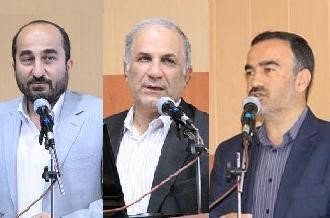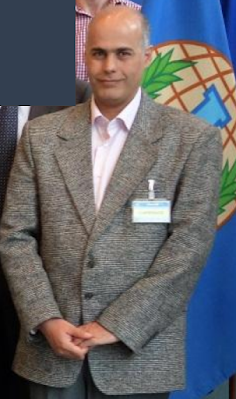The IAP is back - and putting Iran's biggest university at risk of sanctions: Part II
In our last post, we revealed documents showing that in 2016, SPND used the IAP as a nom-de-plume to sign a
memorandum of cooperation with Iran's oldest and most prestigious private
university, the Islamic Azad University Central Tehran Branch (دانشگاه آزاد واحد تهران مرکزی).
There is
a lot of evidence in there that the SPND is behind it. Let’s take a closer
look:
First,
the document is signed by Dr Rouhollah Ghaderi (روح الله قادری), who is described in the document as the
head of the IAP. Here is Ghaderi's signature below on the contract, using a
shortened version of his first name:
We know
from authoritative sources that Dr Rouhollah Ghaderi (national ID 4579489705)
is a long-time, senior official of SPND. In March 2019, the US Treasury put Dr Ghaderi under sanctions for directing SPND's Shahid Fakhr Moghadam Group (گروه
شهید فخار مقدم), one of SPND's main research entities. Shahid Fakhr Moghadam
has built explosion simulators and radiation and neutron monitoring and
detection system for SPND, according to the Treasury.
The
second factor that ties the IAP to SPND are the address and phone number on the
document, which - unsurprisingly - just happen to be also used by SPND.
Helpfully
for us, the contract is written on an IAP letterhead, and so it has the IAP's
address, phone and fax numbers on each page. Here's an example:
Here it
is:
And a
nice close-up image of the SPND site at Mojdeh Street, courtesy of Google:
Check
out that enormous wall at the left side of the facility! That's totally normal
and not at all designed to shield SPND from visual scrutiny by the neighboring
apartments. Probably doesn't stop the spy pigeons
though.
And then
the phone and fax numbers. It won't surprise you to learn that the IAP phone
and fax numbers on that contract are also used by SPND. We know that from
health and safety licensing documents released by Iran's Department of Environment,
excerpted below:
Helpfully
for us, you'll note that the Mojdeh Street address is on that documentation
too, along with explicit references to the fact that the Mojdeh site is owned
by SPND.
So
what is this contract between IAP and the Islamic Azad University all
about?
SPND has
a few desperate requirements: money, legitimacy, and access to foreign
technology. For SPND, an agreement of cooperation with Islamic Azad University fulfills each of these needs. Among other things, the agreement binds IAP/SPND
and IAU to collaborate on research projects of mutual interest; mandates that
IAP/SPND help procure and fit out IAU laboratories with nuclear-related
equipment; and enables IAP/SPND to provide employment to IAU postgraduate
students. Through each of these avenues, SPND can hide behind the name of IAU
in order to get funding and to procure foreign tech.
We know
this because SPND has done it all before with a different university. In the
early 2000s, when the IAP wanted to appear respectable, it borrowed the name of
another civilian research institution, the Iran University of Science and
Technology (IUST - دانشگاه علم و صنعت ایران). As an example, here's a research paper authored by the martyred scientist Masoud Alimohammadi (مسعود علیمحمدی), a key member of Iran's pre-2003 nuclear
weapons program, where he describes his affiliation as the "Institute of
Applied Physics, IUST":
The
IAP/SPND and IUST might actually still retain some friendly connections, or it
could just be that the IAP likes to continue to pretend that it is affiliated
with IUST. The IAP's stamp, which we saw on the contract with IAU, even has a
version of the IUST torch-and-cog logo on it:
Not
subtle, guys.
One
contract, one big risk.
With
Washington clamping down hard with sanctions on entities involved in Iran's
military and nuclear programmes, IAU is playing a very dangerous game by
entering into such a close relationship with IAP/SPND. Because of that
memorandum of cooperation between IAU and SPND - which is now openly available
for all to scrutinize - thousands of IAU students and graduates could have
their opportunities to study or work abroad jeopardized.
We're
sure that IAU will want to avoid being formally designated as an entity
supporting SPND's nuclear weapon-related research, and we hope that this
agreement between IAU and SPND will be severed as soon as possible.
There's
just one hitch with that. We suspect that an important figure behind the
IAU-SPND hook-up is Amad Man and aspiring boss of SPND Dr Mohammad Mehdi Tehranchi (محمدمهدی
طهرانچی),
who became head of IAU's Central Tehran branch shortly after the IAU-SPND contract was signed.
He's since risen to become president of the entirety of the Islamic Azad University system, overseeing tens of
thousands of students across Iran.
With
Tehranchi in charge, we think that the IAU-SPND connection is only going to
become closer, unless IAU's students vote with their feet and wallets and shut
down SPND's activities on campus.
















Comments
Post a Comment